Category: Uncategorized
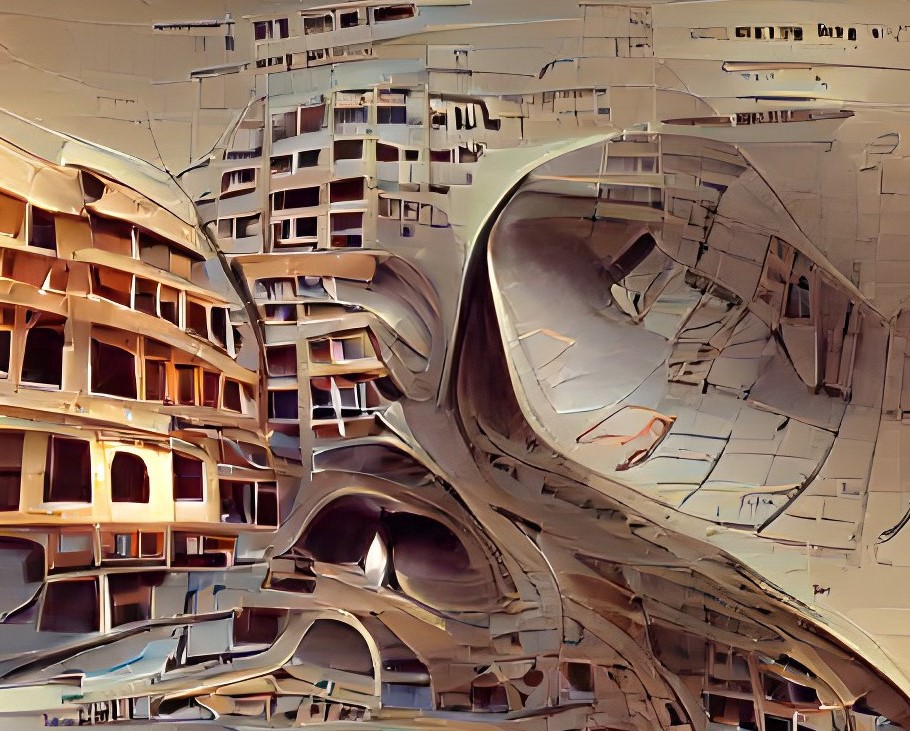
The state of AI web applications for architecture today. And what does the future hold for A.I. technology, architecture, and design?
Architecture is a profession that requires a very complex set of skills, and architecture students have to learn how to use many different types of software before they graduate. The rise of artificial intelligence (AI) and machine learning in the design industry has given architects access to new tools that can help them with their work.
The state of AI web applications for architecture today.
The world of architecture has always lagged behind the world of technology. That doesn’t mean that technology never impacted the architecture profession. Computers were around since the ‘70s, and computers in architecture offices were around since the ‘80s. But all these computer-powered architectural tools and A.I. software solutions (like Revit) came to fruition at least twenty years after such tools showed up in countless other professions, like medicine and engineering, for instance. Still, despite this very apparent lag, many potential synergies between architecture and A.I. have emerged lately, especially within computer vision and machine learning.
Artificial Intelligence (or A.I.) is a topic that often makes the headlines across many industries. Architecture and design will flood into multiple facets of our lives. Whether you believe it or not, artificial intelligence is already a part of your daily life. Your phone uses it to schedule meetings movie recommendations, and dating apps use AI technology to facilitate meaningful connections.
Computer Vision and Artificial Intelligence have already improved how we approach tasks in our day-to-day workflows. The latest developments in this technology are improving by the day, and we are beginning to see it affect each element of our design and architecture process.
From generative design to AI analysis and 3D modeling, AI is becoming more and more integrated into the architecture.
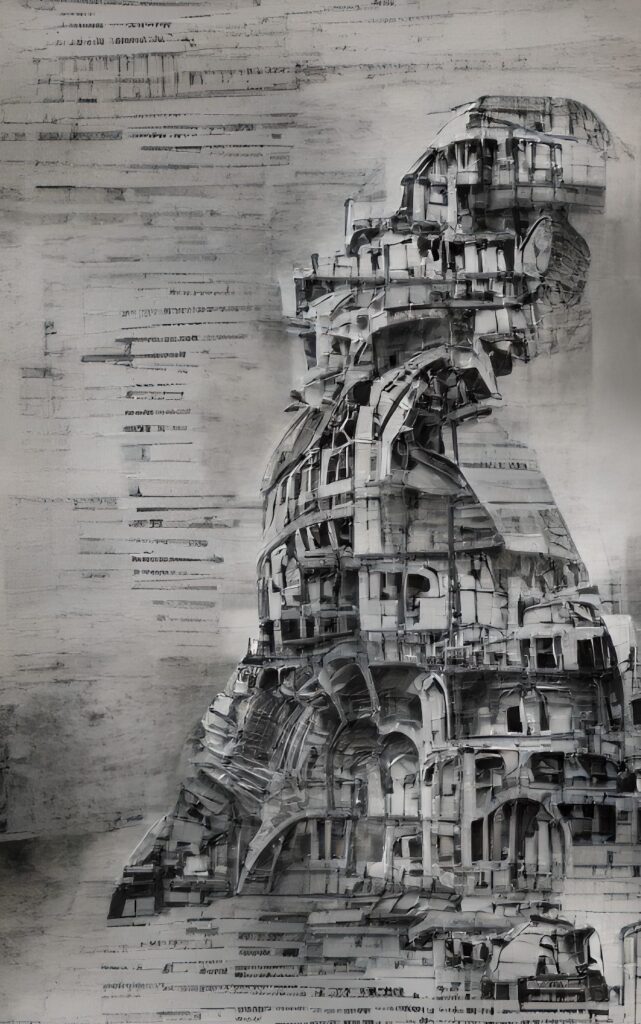
And what does the future hold for A.I. technology, architecture, and design?
In an industry that’s barely touched by the digital era, artificial intelligence (or A.I.) is poised to change the architectural design and construction landscape. A.I. has already begun to transform the way architects design their workspaces and, most importantly, how they design/build their buildings.
Today, Artificial Intelligence (A.I.) is mainly associated with robotics and automobiles. But AI is also a promising technology in architecture and design. The future of A.I. technology in architecture and design will be far different than what sci-fi movies have portrayed. It will not manifest only as machines that look like humans and perform complex tasks. Instead, it will exist as a framework for quickly managing and performing large amounts of data.
Designers are used to working with tools that can generate new forms and shapes based on the rules we provide. Tools like Grasshopper, Dynamo, and others have been used for years to generate design from sets of rules. The next step is to give those rules so that a computer can understand them.
Artificial intelligence is a promising avenue for design and architecture. I think we will see its potential demonstrated in the coming years. As architects and designers, we need to be involved in this process, as users of the technology and creators of content for it.
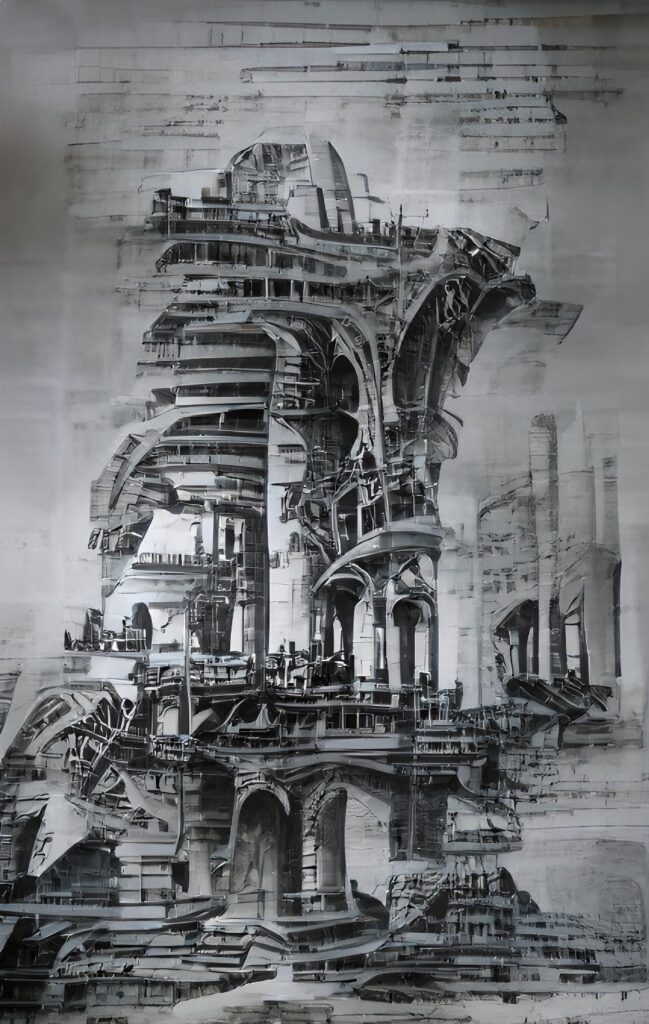
Conclusion
The main advantage A.I. has over human designers and architects is the ability to analyze and understand information faster, with better precision and accuracy, and without bias or emotions.
While this makes it an effective tool for generating proposals and possibilities, certain aspects of architecture require judgment from humans: the integration of the building in its surroundings, its relationship to open space, the selection of materials and finishes, etc.
These are areas of architecture where A.I. may not yet be able to assist as much as we would want it to; however, giving it access to such a large number of possibilities will surely help us make more informed decisions.
Designing buildings is an art, architectural pedagogies and professional practices a science. Artificial intelligence (AI) is allied with the sciences, so it would seem natural to expect AI in the design and architecture professions. Maybe AI will use it to generate stories about how a building came to be. Or how AI is being used to write articles. Like this one!
This article was written with Copy.ai and the images made in dream by app.wombo.art .
Infrastructure and European Integration: a review of a few essays from the Journal History and Technology Vol. 27, No. 3 September 2011.

I have always found the link between illustration graphics and manifestos, power, and political views fascinating. Many of the most critical projects that have shaped the ideas and concepts in architectural discourse have not been built. However, their representation (drawings, models, and texts) has been critical in producing new paradigms in architectural design.
Borders and Infrastructure
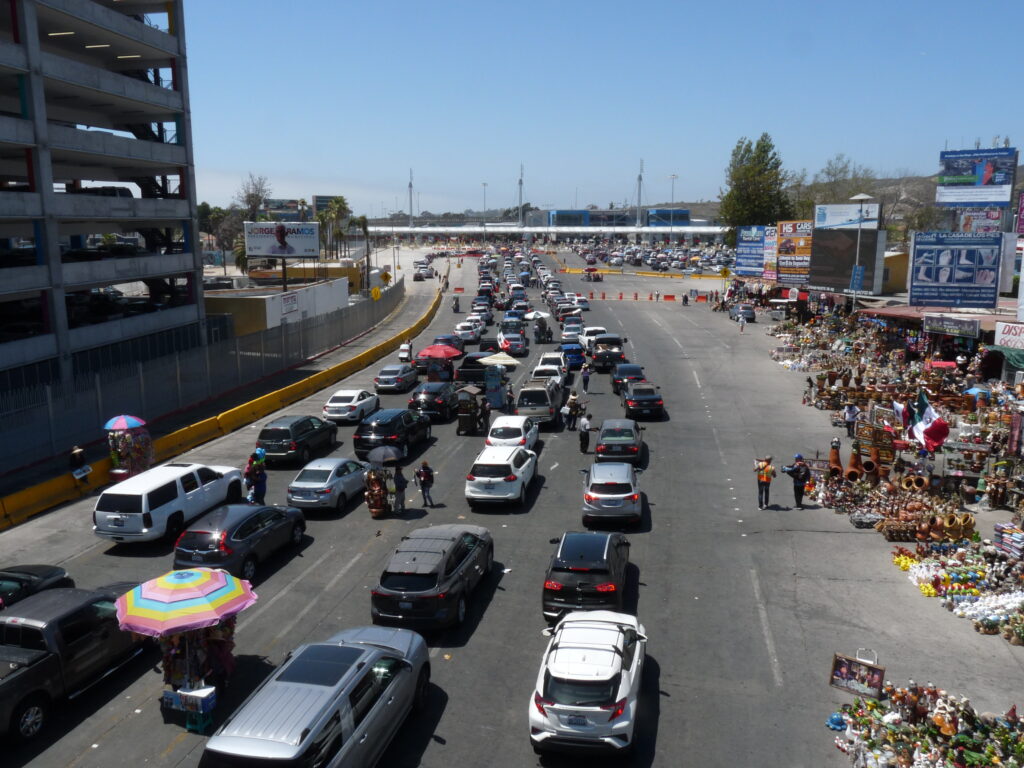
In the special issue of History and Technology devoted to Infrastructural Europeanism, Schipper and Schot point out the importance of infrastructure in nation and region integration in Europe. The first intent for continent integration was in 1950 with the Coal and Steel Community, an organization with power beyond borders. The authors identify these attempts to construct a new Europe by building and administrating infrastructures across national borders. This notion of infrastructural globalism was a “project for permanent unified, world-scale institutional, technological complexes that generate globalist information not merely by accident, a by-product of other goals but by design” (Schipper & Schot, 2011). Moreover, the term “infrastructure” had to be re-defined and accepted beyond the standard French definition. By 1950 the word was part of the semantic dispute. One of its most vocal critics was Winston Churchill, who said, “The original authorship is obscure, but it may well be that these words’ infra and ‘supra’ have been introduced into our current political parlance by the band of intellectual highbrows who are naturally anxious to impress British labour with the fact that they learned Latin at Winchester.”
This rebuke did not prevail, and by 1960 the term referred to other non-material networks such as social and communication infrastructures. Historians explain that infrastructure created an imagined European community of transnational networks. It is relevant to point out that the emphasis on infrastructure making went beyond national or regional boundaries. It also dealt with global issues such as cross-border flows of people, goods, data, and energy. By 1990, Europe was a ‘zero-friction society’ with seamless mobility of capital, goods, people, and services. Today, this European seamless mobility is still limited to certain countries and excludes others, as in the case of some eastern European nations (Schipper & Schot, 2011).
The US/MX border region may have something to learn from the integration efforts of mid-twentieth-century Europe. Yet, there is a history of racism and xenophobia is still much alive in the territory. Across the American border region, some challenges might be resolved by shared or mutually conceived infrastructures. However, a difference from the European example is that the US/MX border region is a contested political space. More than an imaginary border or region (Anderson), it is a ‘real’ place with border actors (citizens, commerce, industry, etc.) and institutions creating binational policies. The border is a physical place and usually consists of cities from both countries coming together at the political division.
The lesson or questions are how a region of flows (people and goods) takes advantage of shared infrastructure, allowing regional sovereignty beyond the centralized visions of national capitals. The US/MX border cities are assemblages that can produce infrastructures capable of organizing social and technological infrastructure across borders.
Image, Technology, and History
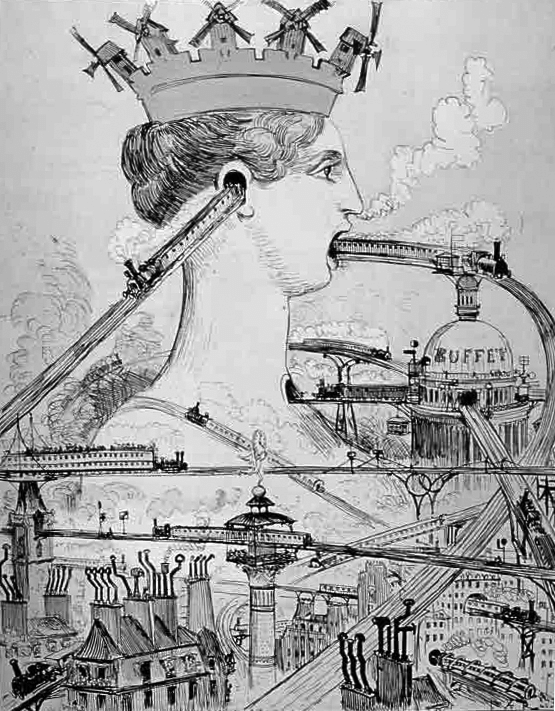
Images are a type of infrastructure; they communicate ideas, concepts, or the process of producing a design. They are powerful storytelling devices. Peter Soppelsa examines the cartoon or illustration of the Paris Metro by the French steampunk illustrator and science fiction novelist Albert Robida, published in 1886, portraying how the metro (railway system) might deform and violate the city “the queen city.” The author states, “It was a visual response to a visual problem” (Soppelsa, 2011). In opposition to the Haussmann metro project, a civil counter group was formed and led by Charles Garnier, a neoclassical architect known for designing the Paris Opera House. As a Neo classist Garnier looked at the past for inspiration and aesthetics, he produced significant buildings in Roman and Greek architecture. This form was fitting for elite buildings, signature pieces in the city. Therefore, his disdain for the metro was natural. He perceived structures and forms of steel as solely engineering. Infrastructure in a traditional sense must be invisible, undisruptive to the classical aesthetics of the city. In 1887, Garnier and a group of intellectuals launched an objection against the building of the Eiffel Tower, today a national symbol of France.
Very few cities today have a grand narrative. Infrastructure has been a driver of urban development, sustaining future growth based on demand, migration, labor dynamics, etc. The aesthetic of the postmodern city is one of collage and hybrid themes; there is no urban manifesto or Haussmanian hand that decides the future development or aesthetic of a city.
Images and concepts play an essential role in the marketing and politics of a city. Most cities have postcards with slogans and skylines that promote their economic attributes and urban lifestyles. Today, computer-generated images and models have become essential decision-making tools for government and communities. Through images, the public and policymakers can scrutinize a project (building or infrastructure) and its effect on a community by understanding its form, environmental impact, visual impression, and many other aesthetic and technical factors.
In the past decade, transportation infrastructure has been one of the major themes in urban development and resiliency projects. Along with urban strategies to safeguard and adapt to climate change, urban transportation, air travel, and personal mobility are now essential to planning projects that include housing, economic development, and public space. Max Hirsh evidences that images of infrastructure and technology are vital PR material for the developers and investors for project success and public acceptance (Hirsh, 2011). However, images of new and developing infrastructures tend to leave out the impact and variances that could occur as the general public appropriates these technologies. Within advertising images of services and goods, a particular user has a specific style of living or a suggested allure of transforming the user’s persona by its attainment. This is a common theme in the PR images of private developer condominiums towers in every major city. Buildings that search a specific market or try to create an appeal for a certain kind of living, most of the time the images are directed to upper-class citizens or private investors. This type of image advertising often steers a community into gentrification.

Max Hirsh concludes the text with two arguments. First, the typical user is absent from the official images and needs to be explicitly reintroduced. Therefore, instead of pictures of finished projects, a visual narrative based on a storyboard or comic strip can be helpful in the integration and understanding of infrastructure’s impact upon the broader public.
HyperloopMexa
In 2016 a team of colleagues and I developed a proposal for Hyperloop One, a cross-border system connecting Los Angeles, California, and Ensenada, Mexico. This technology uses a vacuum- tube system that would connect both cities in less than 20 minutes. An automobile journey takes approximately 4 hours, not including the wait at the international border. Currently, this technology is being developed by different private companies (Virgin Hyperloop, Hyperloop Transportation Technologies, Hardt, among others), and all have invested in sophisticated PR images. Videos displaying how Hyperloop will change mobility and long-range transit in cities and regions where the system is implemented. However, the images presented display a system for a social class that is part of the business milieu who travel across regions and borders for business purposes. The pictures of the stations and transport pods are shown with the latest digital technology and stylized futuristic hygienic interiors. The future is always in white.
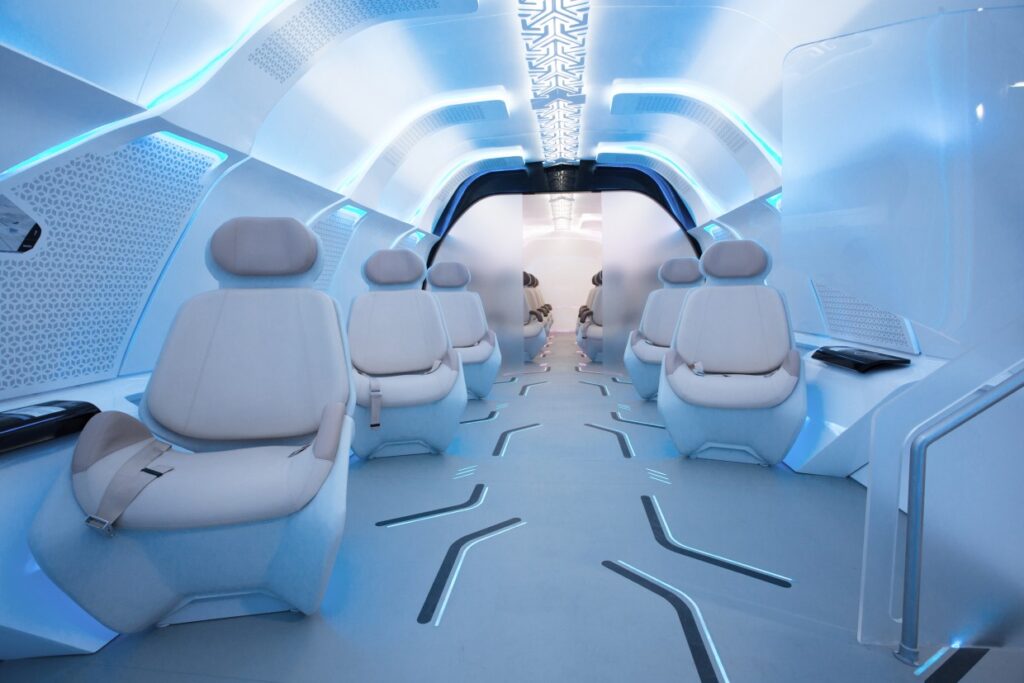
Our work in recent years has studied the realities of the places where the technology will operate, specifically in developing countries. As Max Hirsh points out, “Images provide scant information about how they operate in practice; or about how infrastructure systems, once built, are subsequently appropriated by their users and reconfigured to meet shifting political and economic demands” (Hirsh, 2011). Hyperloop technology images do not show or illustrate how the rest of the population will use and be affected by this disruptive transportation technology. We argued that workers in low-paying jobs such as in the hotel cleaning service, fast food service, landscaping, construction, among others, would be the frequent use of the system and not the Caucasian business class passengers that appear in the PR images. The narrative in the advertising for the system demonstrates a seamless integration between multimodal mobility infrastructure (tubes, stations, buses, etc.) within the urban fabric. However, we argue that as these technologies hit the ground, they will displace or be in conflict with traditional and stable private/public transport systems such as taxis, buses, and other modalities that operate organically in developing countries. New Technologies also discriminate against those who cannot pay for its service through images of social class hierarchies.
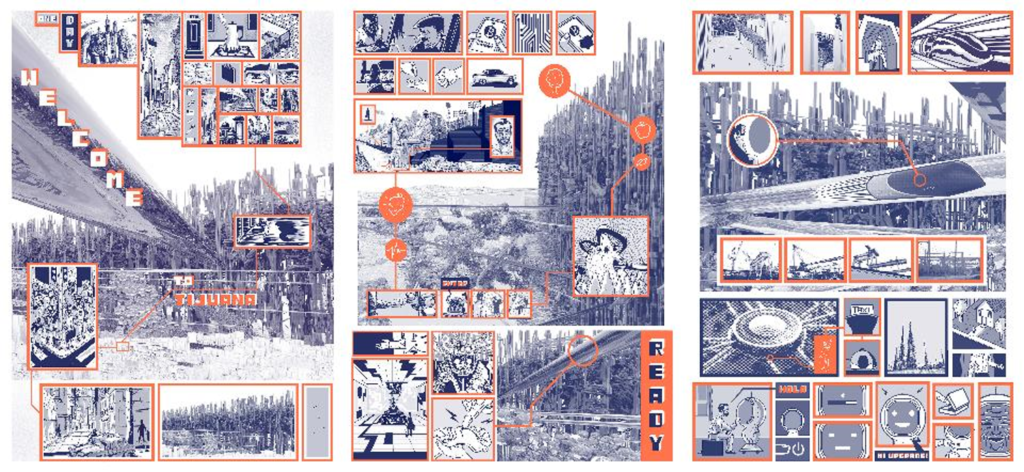
Works Cited
Hirsh, M. (2011). What’s missing from this picture? Using visual materials in Infrastructure studies. History and Technology, 379-387.
Schipper, F., & Schot, J. (2011). Infrastructural Europeanism. History and Technology, 245-264.
Soppelsa, P. (2011). Visualizing viaducts in 1880s Paris. History and Technology, 371-377.
Hola a todos. Ya tenemos la libreta Building Tijuana con hoja cuadriculada (130 pg). De buen tamaño para cargar en bolsillo y plasmar esas grandes ideas sobre arquitectura, diseño, arte, etc. Se pueden comprar por Amazon
Hello everyone. We now have the Building Tijuana notebook with grid sheets (130 pg). Good size to carry in your pocket and capture those great ideas about architecture, design, art, etc. Makes a great gift! You can buy it on Amazon

These days I am experimenting with some sites that use neural networks or artificial intelligence as they call it to create images based on text. In the first image, I typed words that had to do with the informal city and Syd Mead’s graphics. This is what the neural network created after 2000 iterations.
If you want to create some images yourself here is the link to the Ai page. https://colab.research.google.com/…/1lx9AGsrh7MlyJhK9Ur…

The shantytowns of Latin America are the future of cities. Oil painting by Diego Rivera

In the background, the city crouching on distant hills dissipating under a gray mist of a cold morning. There is no sign or sigh of human life. Painting by HG Giger

The shantytowns of Latin America are the future of cities. oil painting. By Mobius

The shantytowns of Latin America are the future of cities. By Gerhard Richter

The shantytowns of Latin America are the future of cities. By Le Corbusier

The shantytowns of Latin America are the future of cities. By Gaudi

Quiero felicitar a Monica Arreola, arquitecta y artista Tijuanense por su inclusión en la Whitney Bienal del 2022 con su proyecto desinterés social.
I would like to congratulate Monica Arreola, architect, and artist from Tijuana for her selection to the Whitney Biennial 2022 with her project “desinterés social”.
Para ver la obra / To see the project: https://www.monicaarreola.com/desinteres-social
https://whitney.org/exhibitions/2022-biennial
Aquí un breve texto sobre una de las fotografías de Arreola . Here is a brief text reagarding one of Arreola’s photographs.

This photograph hides nothing. The photograph makes visible the absence of a home. Three rectangular structures of derelict or still borne houses are centered in the composition, each with two dark square openings as if staring back at the viewer. In the foreground, a landscape of dead lawn patches and a few invasive greeneries create a datum for the aborted homes. In the background, the city crouching on distant hills dissipating under a gray mist of a cold morning. There is no sign or sigh of human life. The landscape is desolate. The only fragment of urbanity is a semi-finished perimeter wall of an adjacent gated community displaying a couple of insipid graffiti tags.
The camera angle frames a one-point perspective, an architectural graphic device, and a virtual view of the world, unlike how we see with our own eyes. By looking at the image, we do not know why the photographer used that point of view. There is no accurate way to be in a place. However, I cannot seem to divert my attention from the writing on the walls, the scribble of signs or words in black outlines, and others in faint orange. Tagged with no apparent order, nevertheless widespread on the surface to produce an aesthetic mood of the objects. The photo also has cumulus clouds!
Rene Peralta
The hybrid structure, part bridge and part building flanked by two large paraboloids made of concrete housed the immigration offices of the Mexican government. It was colloquially known as “la concha” or the seashell to all who waited in line to cross into the US via the San Ysidro Port of Entry in Tijuana. The building was abandoned, uncared-for during its last years, and finally demolished in 2015. As Alejandra Lange points out, critics sometimes have to step into the role of activist (Lange, 2012), and when I found out that the federal government wanted to demolish the structure, I did. I joined others in the struggle to preserve the building. Historians, attorneys, artists, and the general public held live debates near the building to show solidarity for one of the last modernist buildings left in the city.

The building mattered because it complied with two of Riegl’s categories, use-value and newness value (Riegl, 1982). However, it was also a signature of Mexican modernism and paraboloid concrete construction made famous by Felix Candela. La Concha was a testament that there was a time when Mexico and Tijuana wanted to be modern. The building was not only a magnificent building but part of a more significant project, the modernization of ports of entry in Mexican border cities. Architect Mario Pani directed the federal initiative known as the Border National Project of 1965 and oversaw most of the design and construction for the country’s modern open land ports.
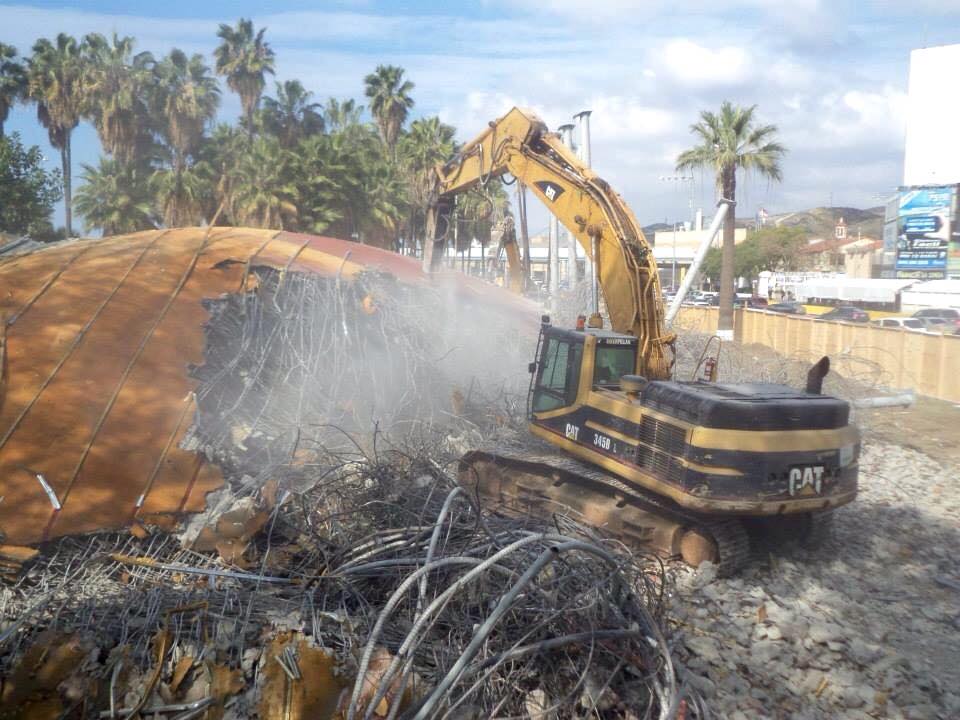
Lange, A. (2012). Writing About Architecture: Mastering the Language of Building and Cities. New York: Princeton Architectural Press.
Riegl, A. (1982). The Modern Cult of Monuments: Its Character and Its Origin. Oppositions 25, 21-51.
As we analyze 20th-century global empire building, we must consider distinct actors in addition to hegemonic nation-states that challenged physical systems, organizational and political infrastructures, market-driven economies, and other drivers of national and regional sovereignty. In Large Technological Systems (LTS), such as shipping and rail infrastructure, there is a second layer of global private/public relationships apart from international agreements within national and global stations, ports, and networks.
Indecorous Concessions. In the article, The Suez Company’s Concession in Egypt, 1854—1956: Modern Infrastructure and Local Economic Development, Caroline Piquet demonstrates the transformation of the Suez Canal from a colonial LTS infrastructure into a symbol for Egyptian national independence.
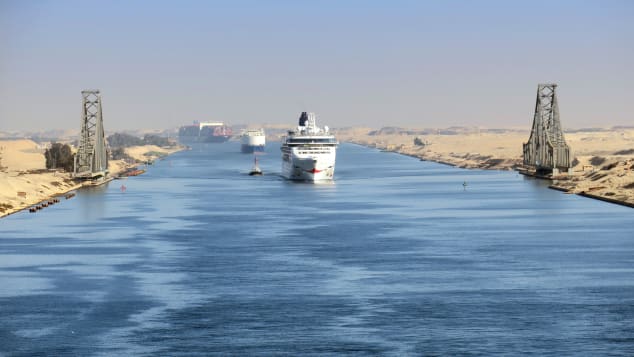
Soeren Stache/picture alliance/Getty Image
The struggle by Egypt for control, management, and operation of the Suez Canal was part of the confrontation to re-possess one of the most extensive and expensive canals of its time. Built-in 1869, it was one of the world’s most extensive canals, creating economic value favoring shareholders in Europe. During the 20th century, the canal was a contested infrastructural landscape, and in 1956, Egypt took control and began to operate the canal.
Since its construction, the training in complex technical knowledge for the canal’s operation was reserved for European engineers, and local Egyptian workers were trained for low-skill operations. However, the canal’s nationalization was a successful event, and its subsequent operation was a profitable one. “The canal belongs to Egypt and not Egypt to the canal” (Piquet, 2004) . The Suez became an essential asset for the economy and sovereignty of the country.
For over 100 years, the canal was an infrastructure in a country that did not benefit from its operation. As a concession, the investment was made to favor European capital. As Piquet writes, “Thus the concession system appears less as an instrument for the spread of global capitalism to all nations, and more as a tainted for of “colonial” capitalism” (Piquet, 2004).
Time is on my side, yes it is. In Jules Verne’s famous novel Around the World in Eighty Days, the principal character Phileas Fogg uses countless modes of transportation to travel around the world. Phileas Fogg is the modern subject, the universal man that navigates the globe, and in every place he visits, there is a possibility of movement. No matter how primitive the system is, his journey becomes part of a larger global mobility culture. Fogg is interconnected with global time and its dramas, psychologies, and stress of a soon-to-be globalized planet. “In this sense, the novel is a technology for the imagining of people’s synchronization in time (Grossman, 2013).

The organization of something so abstract as time is the driving metric of modernity. We no longer arrange daily life based on the sun’s path. We reorganize schedules and tasks according to efficiency, costs, markets, and production. Transportation linked to labor and markets is part of the time machine that modern man must always be aware of. In Verne’s novel, time becomes the main character, even more, critical than Fogg’s journey. Time is always ahead, apparent, and a force to be reckoned with. Verne makes time reckoning more rapidly and is scripted. “The novel – which significantly loses in its English titling that ‘Le tour du monde.’ also means the turning of the earth – spilled quite directly over into this historical context. Four months after its publication, Verne addressed the French Geographic Society on the question of which meridian should be chosen for travelers to separate one calendar day from another worldwide” (Grossman, 2013).
Eleven years later, the world accorded how to measure and keep time around the globe.
Il Duce’s Way. The road-building projects set out by the Italian Fascist in Africa were as much propaganda as critical infrastructure. As Roland Barthes describes, if it was crucial, it relied on the ability to be photographed as a connoted message of empire-building and infrastructures. According to Andrew Denning, “Such audacious roadworks demonstrated an essential claim of Mussolini’s fascist movement: that Il Duce’s regime had accepted the inheritance of ancient Rome but had updated it with the Italian mastery of modern technology. Roads were timeless forms of imperial power and manifestations of fascist modernity simultaneously” (Denning, 2020). The aesthetic ideology found in Mussolini’s aspiration of colonial empire seems to originate via the Italian Avant-garde of the early 20th century. This display of contemporary technology echoes the sentiment of the Italian Futurist, specifically its leader and manifesto author Filippo Marinetti.
Italian Futurism proposed an aesthetic of speed—a movement absorbed by the machine, precisely the automobile in all its violence and terror. Machines and war were part of the allure of violence that the Futurist needed, and the desire to participate in militarization acts as an aesthetic project. New ways of moving and being in the world concerning time/speed became part of a new “machine” sentiment that included a no-return to tradition and histories before the industrial turn of European society.
It is this aesthetic lure with machines, speed, and war that the futurists see as the potential in the fascist project. In Politics as Art: Italian Futurism and Fascism, Anne Bowler explains, “This nonhuman and mechanical being, constructed for an omnipresent velocity, will be naturally cruel, omniscient, and combative” (Bowler, 1991). For Marinetti and the Futurist group, who actively campaigned and subsequently fought for Italy’s intervention in the war and the coming to power of Mussolini and the Fasci di Combattimento, the dictator represented the ultimate triumph of the Futurist-Fascist revolution that Marinetti envisioned under the direction of a new “proletariat of geniuses,” an elite cadre of Futurist artists and intellectuals.” However, For Marinetti, Art was no longer tied to its Roman history, and he denounced any past link or precedent. Art was a transcendental endeavor to create a new nationalism and morality based on technology (Bowler, 1991).
Road-building was a way to modernize the colonial ideals and prepare society for technologies or machines that would change the time-space primitive environment. Italians fetishized technology in a way that produced an aesthetic and political zeitgeist for most of the early 20th century.
Denning said, “Roads were timeless forms of imperial power and manifestations of fascist modernity simultaneously “ (Denning, 2019).
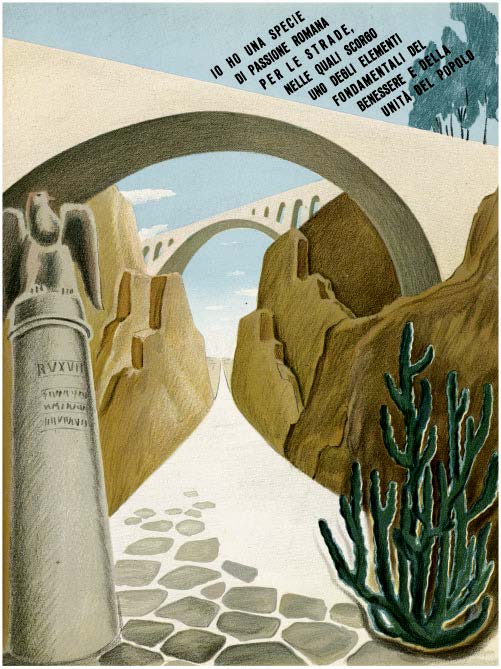
Miami Beach, Florida, The Mitchell Wolfson, Jr. Collection, XB1990.587. Photo: David Almeida.
References
Bowler, A. (1991). Politics as Art: Italian Futurism and Fascism. Theory and Society, 763-794.
Denning, A. (2019). Infrastructural Propaganda: The Visual Culture of Colonial Roads and the Dosmitication of Nature in Italian East Africa. American Society for Environmental History and Forest History Society, 352-369.
Grossman, J. H. (2013). The Character of global transport infrastructure: Jules Verne’s Around the World in Eighty Days. History and Technology, 247-261.
Piquet, C. (2004). The Suez Company’s Concession in Egypt, 1854-1956: Modern Infrastructure and Local Economic Development. Enterprise and Society. Vol. 5 No.1, 107-127.
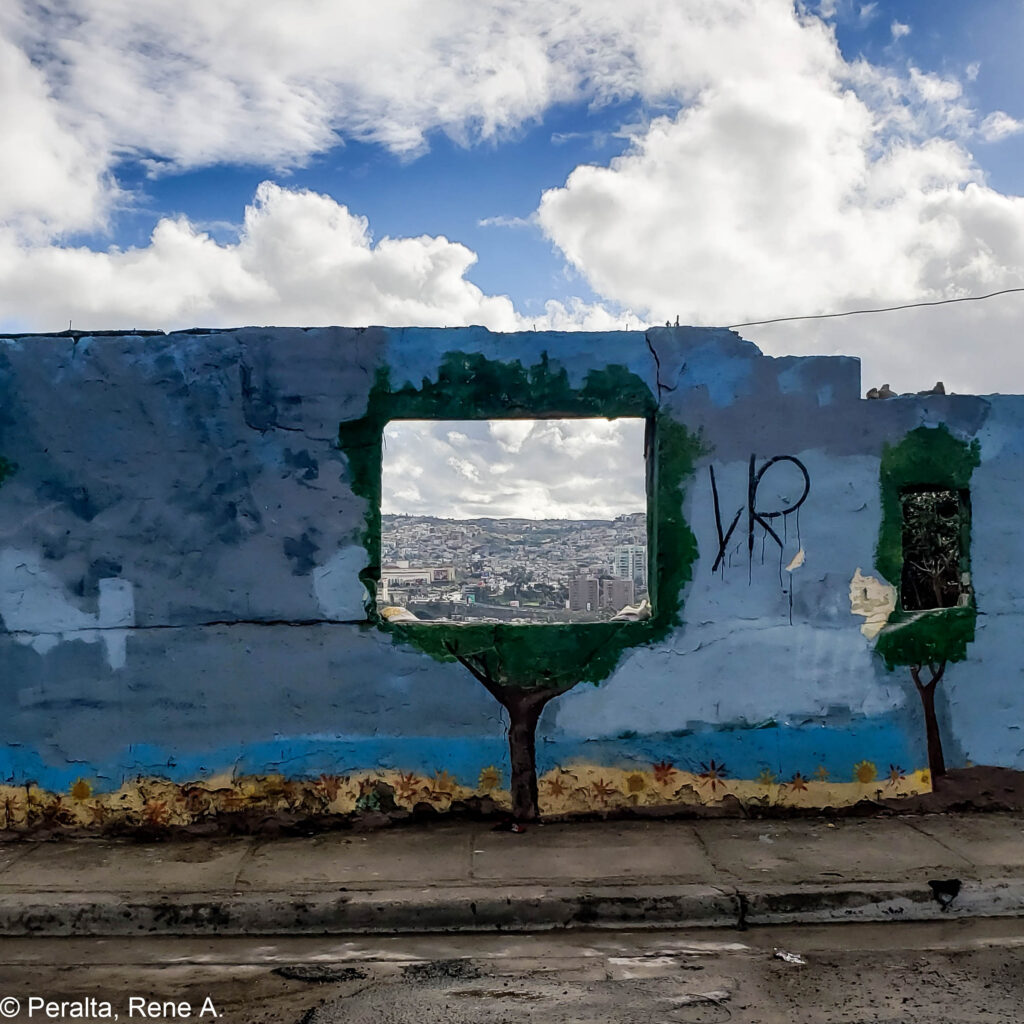
Manufactured landscapes. Infrastructure and nature’s relationship as an artificial sociotechnical entity is a fascinating undertaking. However, we should not fall into simple human/nature binary assumptions. Infrastructures do not separate humans from their environments. Instead, they overlap as new or different assemblages of human and non-human nature. Infrastructures allow us to understand the construction of our environment. However, they can’t be fully naturalized either; they are manufactured landscapes (Zeller, 2017). According to Neil Everden, if the concept of nature is a social construct, we might be confusing nature with threats of pollution. Ecological infrastructure (re)produces[1] the burden or stress we experience in terms of socio-ecological or political power (Everden, 1992).

Environmental citizenship. At a planetary scale, techno-politics and ecological politics are inextricably complex. Examples vary from the Pana Canal’s water management and forest preservation tactics to interstate roads and highways in the US and many other water management projects built in India and China, including dams, canals, and hydrological distribution systems. Timothy Mitchell refers to projects at this scale as “capital infrastructures .”He proposes that infrastructure is a politics of nature produced in infrastructure (Mitchell, 2014). As Everdeen also implies, it has a social use, and finally, we experience nature via the infrastructure we build (Everdeen, 1992).
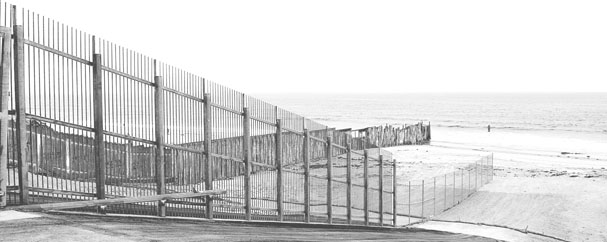
Nature, therefore, cannot be assumed as background. The possible interpretations of the study of nature and infrastructure set up a series of Large Technological Systems (LTS). According to Ashley Case, LTS systems can also be part of political struggle. The US/Mexico border acts as a political divide and a sociotechnical and militarized infrastructure. The wall separates two nations and two different sociocultural systems and acts against ecological preservation efforts. The border wall transgresses sensitive ecological reserves that are part of a shared watershed between San Diego and Tijuana. It impedes traffic of human (undocumented) and more-than-human[2] entities such as seeds, plants, mammals, and reptiles, that are part of the pristine ecosystems shared by the two countries. The physical metal structure of the border ends in the sandy beach of Tijuana and plunges into the ocean, demonstrating its global hegemony thru techno-environmental politics. The US national public has seen the wall as a determent infrastructure. In academic studies, including urbanism, urban geography, or infrastructural studies, the wall has been subjected to harsher criticism for its ecological and geopolitical imperialism and as an act of urbicide[3].
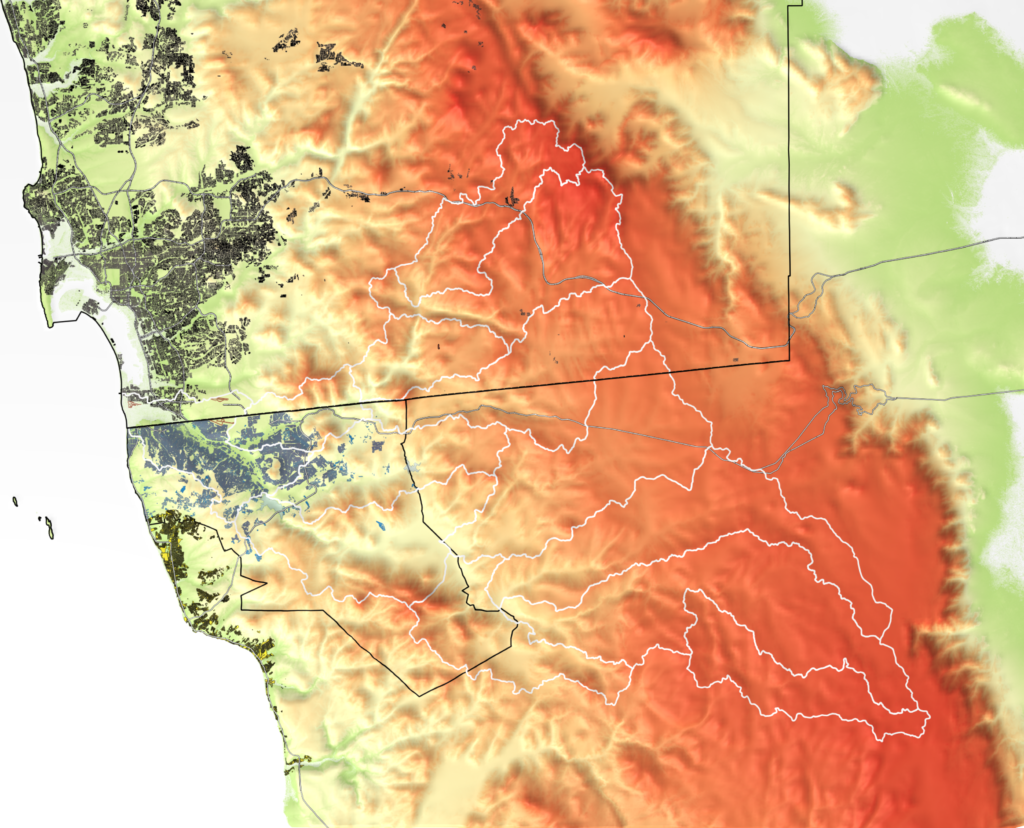
Sophia Stamatopoulou-Robbins recounts that electricity systems, landfills, and water infrastructure in the Israel and Palestine border are power devices. However, infrastructure could bring together interests and individuals across political boundaries, demonstrating a post-national environmental commitment (Stamatopoulou-Robbins, 2014). Therefore, these border infrastructural systems deployed between US/Mexico can be devices for cooperation instead of separation.
For urgent binational cooperation, a case in point is the All American Canal that transports water from the Colorado River to the US southwest region and into Mexico. The city of Tijuana gets most of its water from the canal and seepage from the ground of the channel used to fill natural reservoirs that served the agricultural community of the Mexicali Valley. Recently, the US decided to line the canal’s floor with concrete due to the region’s sustained drought cutting off Mexican agricultural lands from the water necessary to grow their crops. Ironically, many of these agricultural products produced in Mexico are exported to the United States. Could there be an environmental citizenship claim over national ones, allowing both sides to share the resource equally? (Stamatopoulou-Robbins, 2014)
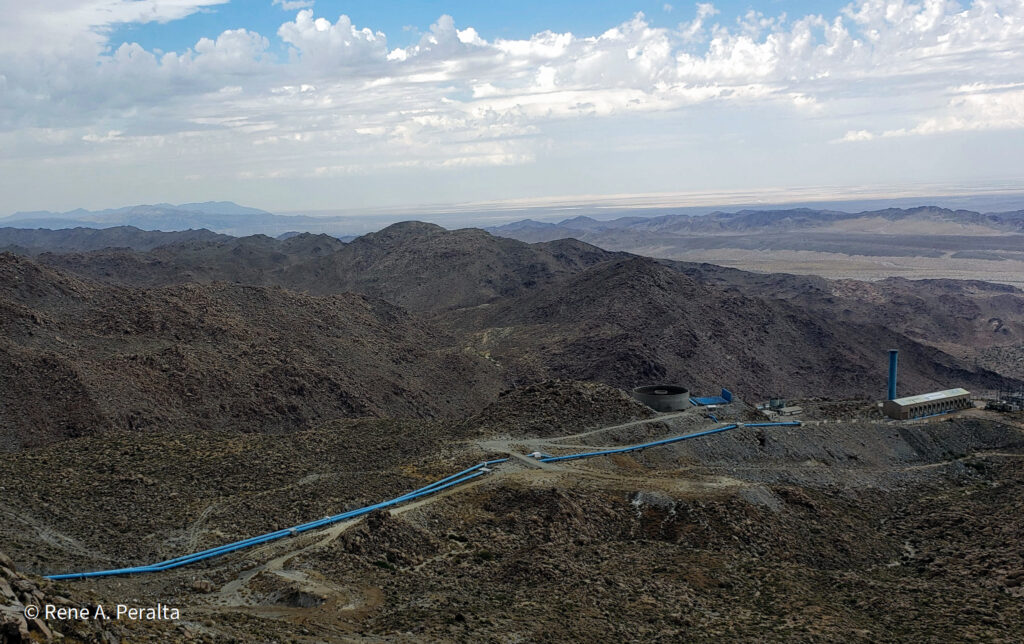
Mobile Umwelt. Mobility in many border cities along the US/MX border is dominated by the private automobile for two reasons: Many of the cities along the border developed their mobility infrastructure during the 20th century, roadbuilding became the main form of connectivity between binational urban and rural areas. Second, the export of vehicles from the US inundated the Mexican market with low-cost second-hand cars. Roads have become vehicles of modernity that ‘form us as subjects’ mobilizing ‘after and the sense of desire, pride and frustration’ (Barua, 2021) (Larkin, 2013).
Mobility has shaped socio-economic relations of power (Monroe, 2014). This phenomenon created a social polarization where those who owned used vehicles with California plates were considered economically poor and from different social statuses. At the same time, owners of new cars with Mexican license plates were viewed as middle or upper-class citizens that could afford a car from a local auto dealership. In the same way, municipalities built roads with superior techniques in upper socio-economic areas and working-class communities did not have paved roads or were of inferior quality (concrete vs. asphalt).
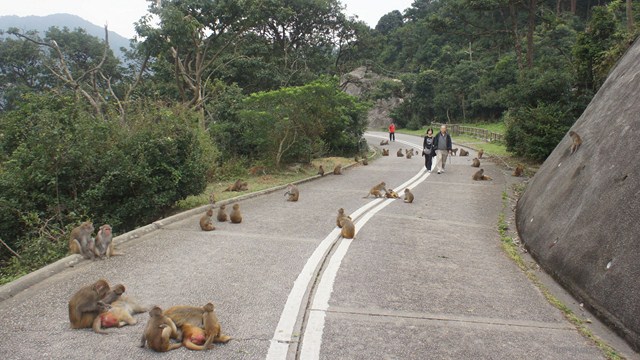
The infrastructure of circulation, such as road networks, impacts more-than-human entities. Roads have become habitat corridors modifying an organism’s flow pattern throughout our global geography. Motorways can also enable the intermixing of habitats that were once isolated or inhibit motion in areas that were natural distinct corridors. From termites traveling for thousands of kilometers in shipping containers to macaques in southern India that gravitate towards roads to get food from passing vehicles, the architectures of circulation are the enmeshment of animals and infrastructure. The material politics of roadbuilding and etho-geography can develop a political ecology of infrastructure, one attentive to animal mobility beyond human-centered environmental impact assessments (Barua, 2021).
Works Cited
Barua, M. (2021). Infrastructure and non-human life: A wider ontology. Progress in Human Geography, 1-23.
Everden, N. (1992). The Social Creation of Nature. Baltimore: John Hopkins University Press.
Larkin, B. (2013). The politics and poetics of infrastructure. Annual Review of Anthropology 42, 327-343.
Lefebrve, H. (1991). The Production of Space. Oxford: Blackwell Publishers Ltd.
Mitchell, T. (2014). Life of Infrastructure. Comparative Studies of South Asia, Africa and the Middle East 34 #3, 437-548.
Monroe, K. V. (2014). Automobility and Citizenship in Interwar Lebanon. Comparative Studies of South Asia, Africa and the Middle East, 518-531.
Stamatopoulou-Robbins, S. (2014). Occupational Hazards. Comparative Studies of South Asia, Africa, and the Middle East. 34 no. 3, 476-496.
Zeller, T. (2017). Aiming for control, haunted by its failure: Towards an environtechnical understanding of infrastructure. Global Envrinoment 10 no.1, 202-228.
[1] I like to use the term produce [man] rather than create [nature] as Henri Lefebvre argues that nature does not produce. “And, yet nature does not labour: it is even on of its defining characteristics that it creates. What it creates, namely individual ‘beings’ simply surges forth, simply appears” (Lefebrve, 1991).
[2] Laura Harjo in her book Spiral to the Stars: Mvskoke Tools of Futurity, mentions that the Mvskoke people refer to non-human entities as more-than-human.
[3] Urbicide is defined as “violence against the city”. The term was first coined by Michael Moorcock in 1963
A brief review of the book; Impossible Engineering: Technology and Territoriality on the Canal du Midi. By Chandra Mukerji (2009).

Imaginative understanding. Conventionally architectural history is taught in chronological sequence or via individual technological or artistic achievements. The historian E.H. Carr mentions, “The historian is necessarily selective. The belief in a hard core of historical facts existing objectively and independently of the historian is a preposterous fallacy, but one which it is very hard to eradicate” (Carr, 1961). Carr emphasizes that a historian needs an “imaginative understanding” of the mindset and era of people being studied. Historiography should be a working model to understand conditions rather than finding an official culprit of past events. Imaginative understanding might be evident in the discipline of the history of science, where research includes technological systems and infrastructural objects produced by various entities (humans and non-human) that span years in their production and operability.
In her book concerning the construction history of the Canal du Midi[1] (1667-1694) in Southern France, Chandra Mukerji exemplifies an essential fundamental shift, a cognitive drive, and prioritization of the “imperative problem.” A task(s) needing resolution to move forward a series of protocols that would prove to be the impetus for future technological paradigms. The building of Canal du Midi did not have explicit technical references, a renaissance figure, or a specific group that analyzed and proposed a scheme. Like the construction of the Duomo in Florence (1436 AD), where the only construction knowledge was guaranteed by Filippo Brunelleschi’s temperament and his careful study of the Pantheon in Rome (125 AD). A problem left to a sole “genius” with the knowledge to uncover all the technical and aesthetic solutions to the given challenge of the time. On the contrary, the construction of the Canal du Midi was a work of collective knowledge by an assemblage of actors with vernacular skills and identities.
Work on the Canal du Midi was initiated during the rule of Louis XIV, yet it relied on a sacred mandate rather than on a political official one. According to the belief system of the time, shaping the earth and managing its natural (resources) was a human right given by God, not the king. Faith in the authority over nature handed down by God made it clear that the means would be found in an unforced and collaborative method. Therefore, the initiative to build a canal 240 kilometers towards the Mediterranean was a vernacular and sacred rite rather than a rational and scientific endeavor. Many of the technologies required to build the canal came from various regions and existed in diverse forms, including knowledge from military or mining brigades, masons, local farmers, and other trades; however, it was still vernacular knowledge.
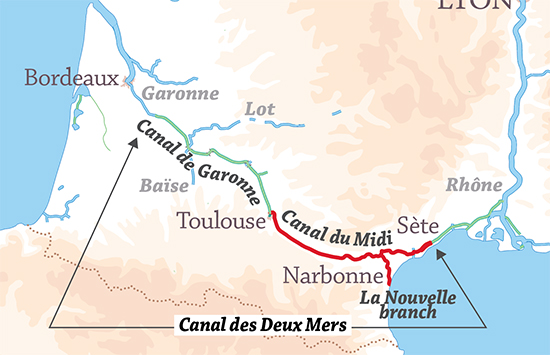
Community Assemblages. Pierre-Paul Riquet (1609-1680) was a tax collector, fluent in engineering and infrastructure construction. Riquet had a vision for the canal in Languedoc and its potential long-term and economic benefits for the region and the country. His occupation facilitated communication with local knowledge and vernacular expertise. Once he gathered the native know-how, the canal became a “product of collective intelligence” of people with different backgrounds who shared their knowledge to undertake such a massive task. Riquet’s leadership and trust in local knowledge allowed the emergence of a bottom-up process assembling itself as skills were required. In his definition of assemblage theory, Manuel DeLanda states, “Assemblages have a fully contingent historical identity, and each of them is, therefore, an individual entity” (DeLanda, 2016). An assemblage forms when a community comes together; however, it leaves personal identities intact. DeLanda continues, “To properly apply the concept of assemblage to real cases we need to include, in addition to persons, the material and symbolic artifacts that compose communities and organizations: the architecture of the buildings that house them; the myriad different tools and machines used in offices, factories, and kitchens; the various sources of food, water, and electricity; the many symbols and icons with which they express their identity” (DeLanda, 2016) Riquet was able to employ community assemblages consisting of unique human and non-human entities for his grand project.

As DeLanda argues, community assemblage must also consider artifacts (non-human entities) as part of the expertise brought by a community. Machines, tools, and other technical objects are part of the expertise that Riquet found across the region. The canal was a social engineering experiment that brought together community desires, knowledge, and identities to produce a shared vision. The collaboration in Languedoc included groups who spoke a different language, were of different gender, education, and social status. common link between the different groups was a desire to embrace their classical roman history, a symbolic attitude studied and traditionally handed down through generations. This classical past was already part of the region’s social life and community activities (farming, herding, running mills, irrigation, agriculture). “It was this kind of knowledge: the intelligence of bandits, fishermen, washerwomen, masons, charcoal makers, and women indigenous engineers – that made it possible to build a canal in Languedoc” (Mukerji, 2009).
“In this empire, the art of cartography was taken to such a peak of perfection that the map of a single province took up an entire city and the map of the empire, an entire province.” Jorge Luis Borges in A Universal History of Infamy, 1946
World-building. Cartographies possess power. For centuries maps have represented colonial power, illustrated economic trade routes, land acquisition, and the places of future struggles. Maps are a proxy of the real, yet they also suggest new relationships, possible outcomes, and even new possible worlds. Before and during the construction of the Canal du Midi, cartographers documented chart locations, building techniques, topographical modifications, and other manipulations of groundworks and infrastructure in the European landscape. For the building of the canal, two types of maps were of interest; maps from military surveyors with academic training where measurement was of utmost importance and local civil maps of “humble” origins. Local maps represented current natural phenomena, artificial landscapes, and everyday life activities, depicting the relationship (legal, physical, or jurisdictional) areas of community activity such as farming, living, crops, and other activities linked to local biomes. As different cartographies and map-making methods were deployed, Riquet cultivated the combined intelligence of each group. There was no central or holistic approach (complete method) for mapping or surveying the various conditions that needed to be described, measured, and documented (Mukerji, 2009). The fieldwork for the design and construction of the canal was a palimpsest of local experiences and vernacular knowledge.
It is intriguing how collective knowledge, especially cartographic and mapping techniques during the design and construction of the Canal du Midi, were part of an open-source system combined and assembled in ways beneficial to the intricacies of the project. Eventually, the finished canal became a 17th-century world-building project that modified natural terrain at a regional and planetary scale.
Contemporary world-building techniques use maps, cartographies, narratives, character development, cinematic storylines as a medium for creating scenarios of possible futures. Many of these worlds tend to locate themselves in a future that might include non-human entities, worlds that have mapped a different trajectory away from neo-capitalist agendas and, in turn, depict a space of only potential. Many of the ideas behind these new worlds have their origin in science fiction, game theory, chaos theory, and other non-hierarchical systems. There is no central depository of systems or elements for world-building. Each author or group uses open-source data, digital mapping techniques, everyday user information from personal devices, internet activity, and a combined digital intelligence that measures and describes our world in real-time.
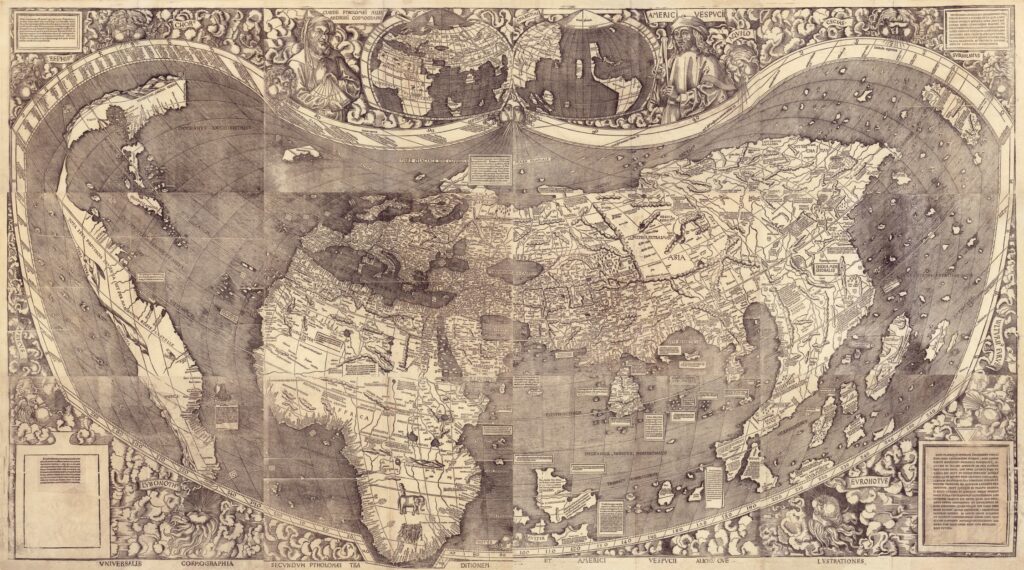
. [Strasbourg, France?: s.n] [Map] Retrieved from the Library of Congress, https://www.loc.gov/item/2003626426/.
Our desire to change and build the physical and virtual world through technology has been part of a human – imaginative understanding of an ideal. World-building was a phenomenon of Christianization, and similarly, religious rituals and contemporary video games share the structure of interactivity, performance and are defined by rules (Wagner, 2012). However, the relationship between ritual and video games is a theme for another time. As Chandra Mukerji describes, for 17-century engineers, the construction of the Canal du Midi was a sacred mandate and part of Christian ethics to claim dominion over the earth.
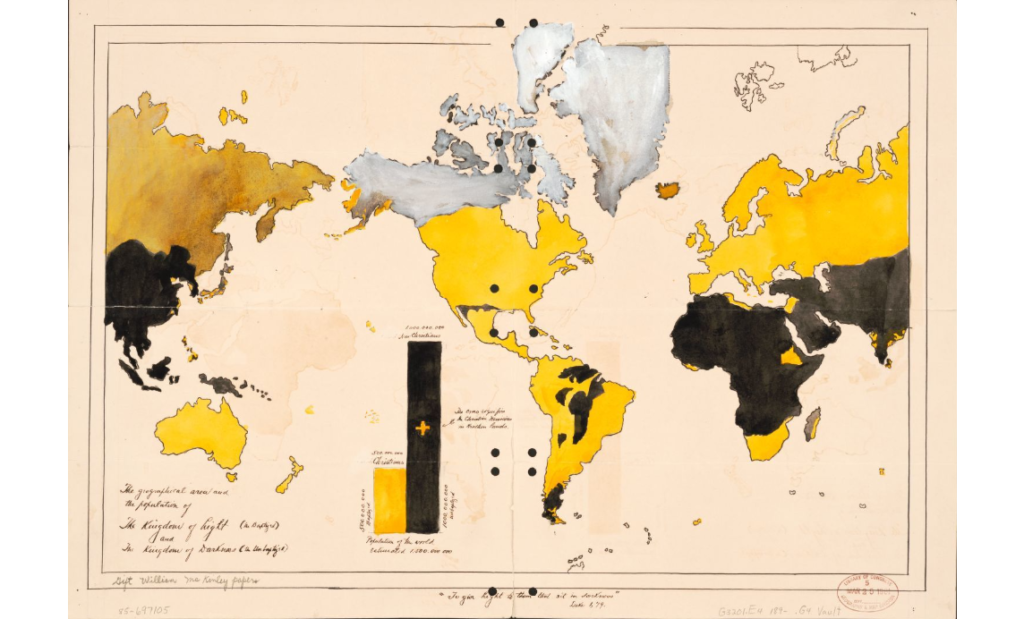
. [189-?] [Map] Retrieved from the Library of Congress, https://www.loc.gov/item/85697105/.
Works Cited
Carr, E. H. (1961). What is History? New York: Random House.
DeLanda, M. (2016). Assemblage Theory. Edinburg: Edingburg Universty Press.
Mukerji, C. (2009). Impossible Engineering: Technology and Territoriality on the Canal du Midi. New Jersey: Princeton University Press.
Wagner, R. (2012). Godwire: Religion, Ritual and Virtual Reality. New York: Routledge.
[1] A UNESCO World Heritage Site. For technical information see https://whc.unesco.org/en/list/770/
